Effective Reward Communication within Organizations
VerifiedAdded on 2023/01/18
|11
|2756
|83
AI Summary
This report discusses the theory and model concerning motivation and communication. The link between the two concepts is discussed in terms of effective reward communication within organizations. Find recommendations for implementing effective reward communication strategies.
Contribute Materials
Your contribution can guide someone’s learning journey. Share your
documents today.
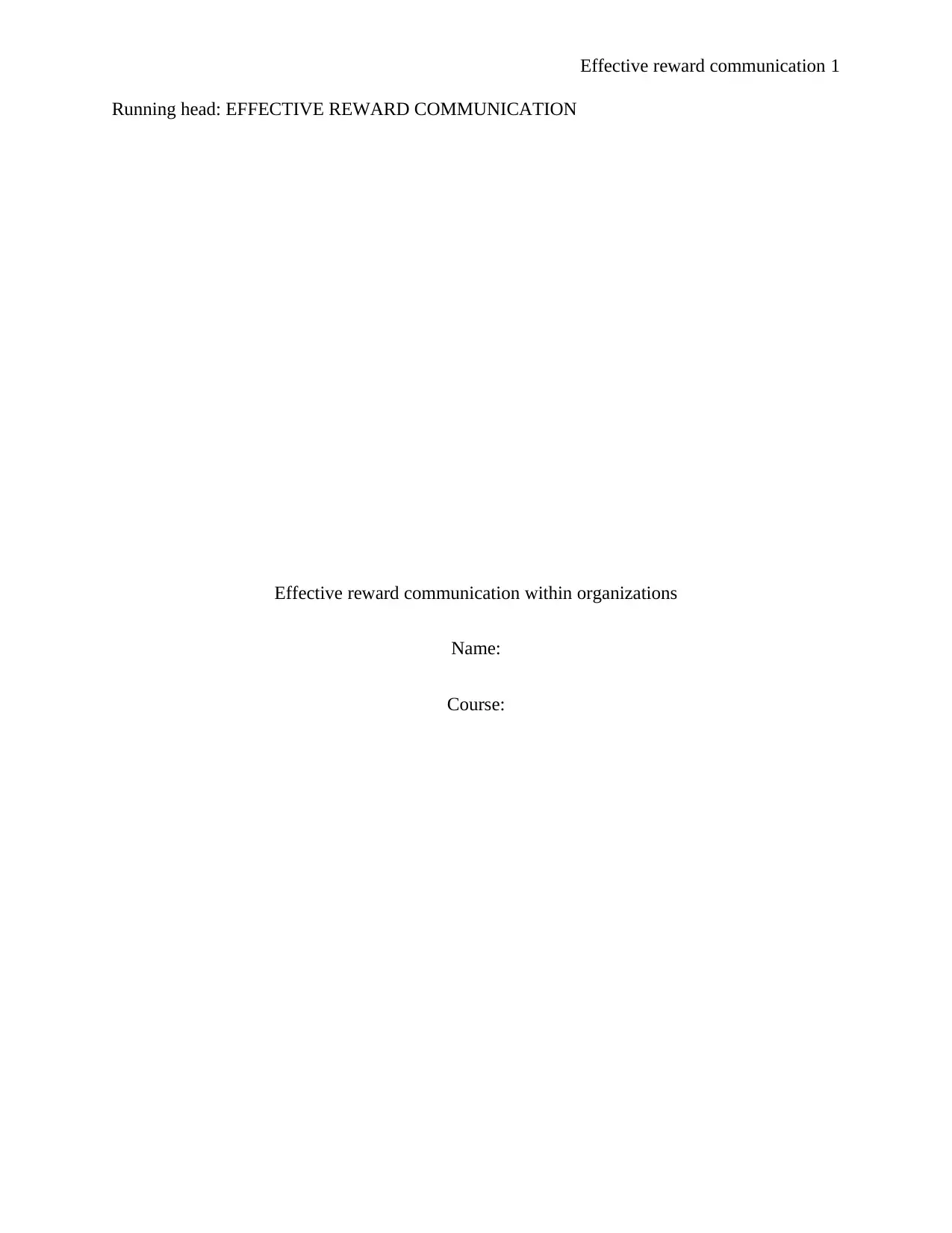
1Effective reward communication
Running head: EFFECTIVE REWARD COMMUNICATION
Effective reward communication within organizations
Name:
Course:
Running head: EFFECTIVE REWARD COMMUNICATION
Effective reward communication within organizations
Name:
Course:
Secure Best Marks with AI Grader
Need help grading? Try our AI Grader for instant feedback on your assignments.
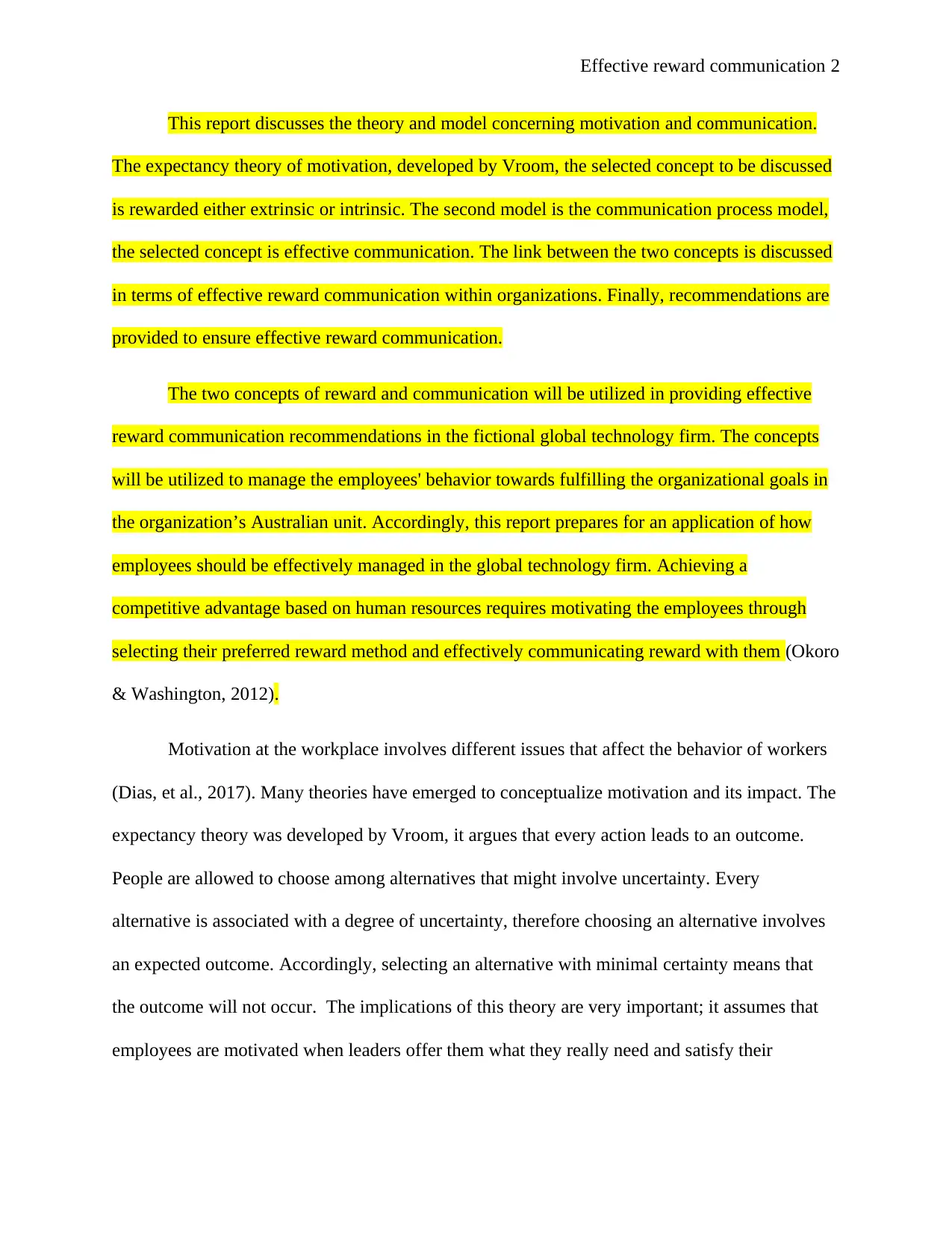
2Effective reward communication
This report discusses the theory and model concerning motivation and communication.
The expectancy theory of motivation, developed by Vroom, the selected concept to be discussed
is rewarded either extrinsic or intrinsic. The second model is the communication process model,
the selected concept is effective communication. The link between the two concepts is discussed
in terms of effective reward communication within organizations. Finally, recommendations are
provided to ensure effective reward communication.
The two concepts of reward and communication will be utilized in providing effective
reward communication recommendations in the fictional global technology firm. The concepts
will be utilized to manage the employees' behavior towards fulfilling the organizational goals in
the organization’s Australian unit. Accordingly, this report prepares for an application of how
employees should be effectively managed in the global technology firm. Achieving a
competitive advantage based on human resources requires motivating the employees through
selecting their preferred reward method and effectively communicating reward with them (Okoro
& Washington, 2012).
Motivation at the workplace involves different issues that affect the behavior of workers
(Dias, et al., 2017). Many theories have emerged to conceptualize motivation and its impact. The
expectancy theory was developed by Vroom, it argues that every action leads to an outcome.
People are allowed to choose among alternatives that might involve uncertainty. Every
alternative is associated with a degree of uncertainty, therefore choosing an alternative involves
an expected outcome. Accordingly, selecting an alternative with minimal certainty means that
the outcome will not occur. The implications of this theory are very important; it assumes that
employees are motivated when leaders offer them what they really need and satisfy their
This report discusses the theory and model concerning motivation and communication.
The expectancy theory of motivation, developed by Vroom, the selected concept to be discussed
is rewarded either extrinsic or intrinsic. The second model is the communication process model,
the selected concept is effective communication. The link between the two concepts is discussed
in terms of effective reward communication within organizations. Finally, recommendations are
provided to ensure effective reward communication.
The two concepts of reward and communication will be utilized in providing effective
reward communication recommendations in the fictional global technology firm. The concepts
will be utilized to manage the employees' behavior towards fulfilling the organizational goals in
the organization’s Australian unit. Accordingly, this report prepares for an application of how
employees should be effectively managed in the global technology firm. Achieving a
competitive advantage based on human resources requires motivating the employees through
selecting their preferred reward method and effectively communicating reward with them (Okoro
& Washington, 2012).
Motivation at the workplace involves different issues that affect the behavior of workers
(Dias, et al., 2017). Many theories have emerged to conceptualize motivation and its impact. The
expectancy theory was developed by Vroom, it argues that every action leads to an outcome.
People are allowed to choose among alternatives that might involve uncertainty. Every
alternative is associated with a degree of uncertainty, therefore choosing an alternative involves
an expected outcome. Accordingly, selecting an alternative with minimal certainty means that
the outcome will not occur. The implications of this theory are very important; it assumes that
employees are motivated when leaders offer them what they really need and satisfy their
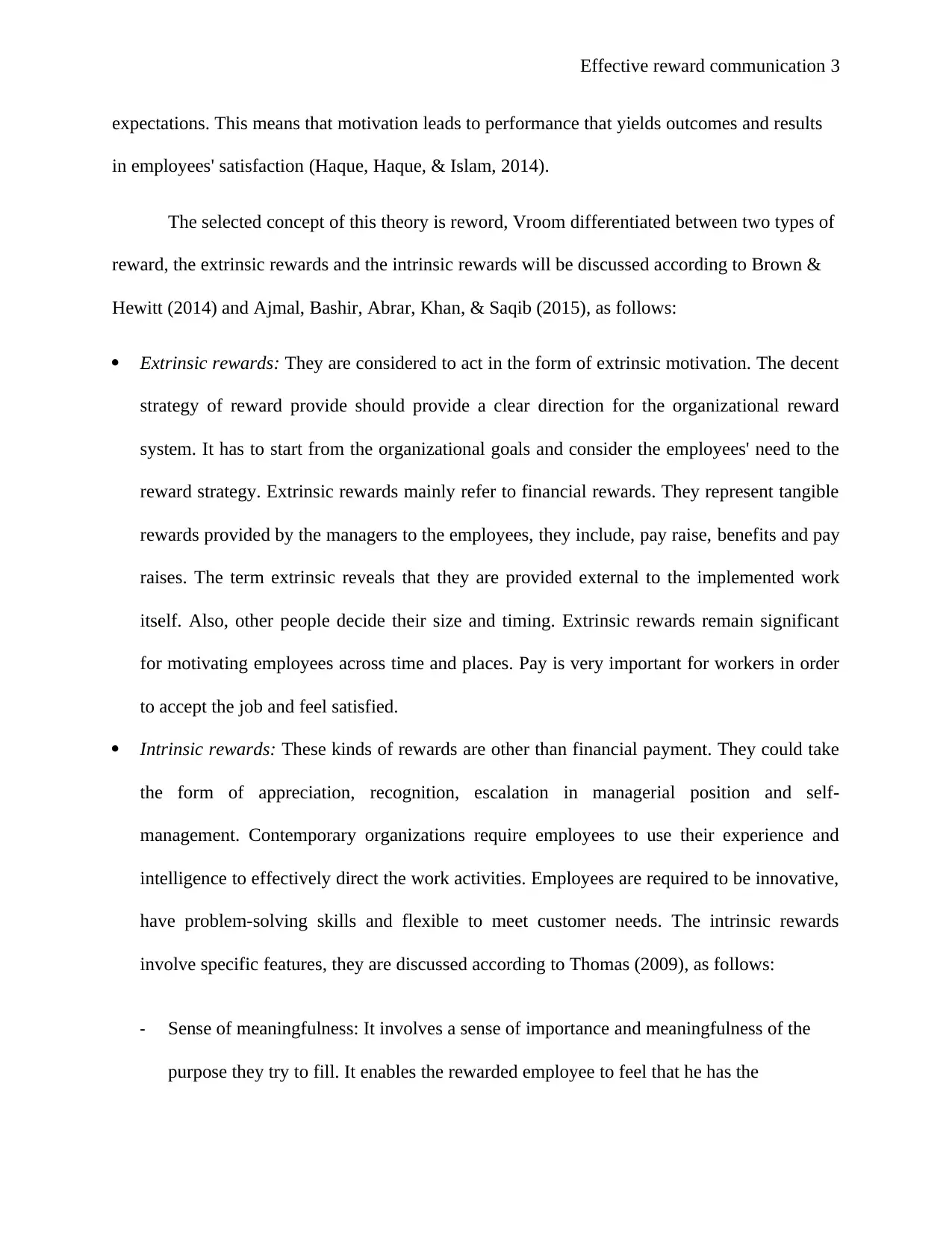
3Effective reward communication
expectations. This means that motivation leads to performance that yields outcomes and results
in employees' satisfaction (Haque, Haque, & Islam, 2014).
The selected concept of this theory is reword, Vroom differentiated between two types of
reward, the extrinsic rewards and the intrinsic rewards will be discussed according to Brown &
Hewitt (2014) and Ajmal, Bashir, Abrar, Khan, & Saqib (2015), as follows:
Extrinsic rewards: They are considered to act in the form of extrinsic motivation. The decent
strategy of reward provide should provide a clear direction for the organizational reward
system. It has to start from the organizational goals and consider the employees' need to the
reward strategy. Extrinsic rewards mainly refer to financial rewards. They represent tangible
rewards provided by the managers to the employees, they include, pay raise, benefits and pay
raises. The term extrinsic reveals that they are provided external to the implemented work
itself. Also, other people decide their size and timing. Extrinsic rewards remain significant
for motivating employees across time and places. Pay is very important for workers in order
to accept the job and feel satisfied.
Intrinsic rewards: These kinds of rewards are other than financial payment. They could take
the form of appreciation, recognition, escalation in managerial position and self-
management. Contemporary organizations require employees to use their experience and
intelligence to effectively direct the work activities. Employees are required to be innovative,
have problem-solving skills and flexible to meet customer needs. The intrinsic rewards
involve specific features, they are discussed according to Thomas (2009), as follows:
Sense of meaningfulness: It involves a sense of importance and meaningfulness of the
purpose they try to fill. It enables the rewarded employee to feel that he has the
expectations. This means that motivation leads to performance that yields outcomes and results
in employees' satisfaction (Haque, Haque, & Islam, 2014).
The selected concept of this theory is reword, Vroom differentiated between two types of
reward, the extrinsic rewards and the intrinsic rewards will be discussed according to Brown &
Hewitt (2014) and Ajmal, Bashir, Abrar, Khan, & Saqib (2015), as follows:
Extrinsic rewards: They are considered to act in the form of extrinsic motivation. The decent
strategy of reward provide should provide a clear direction for the organizational reward
system. It has to start from the organizational goals and consider the employees' need to the
reward strategy. Extrinsic rewards mainly refer to financial rewards. They represent tangible
rewards provided by the managers to the employees, they include, pay raise, benefits and pay
raises. The term extrinsic reveals that they are provided external to the implemented work
itself. Also, other people decide their size and timing. Extrinsic rewards remain significant
for motivating employees across time and places. Pay is very important for workers in order
to accept the job and feel satisfied.
Intrinsic rewards: These kinds of rewards are other than financial payment. They could take
the form of appreciation, recognition, escalation in managerial position and self-
management. Contemporary organizations require employees to use their experience and
intelligence to effectively direct the work activities. Employees are required to be innovative,
have problem-solving skills and flexible to meet customer needs. The intrinsic rewards
involve specific features, they are discussed according to Thomas (2009), as follows:
Sense of meaningfulness: It involves a sense of importance and meaningfulness of the
purpose they try to fill. It enables the rewarded employee to feel that he has the
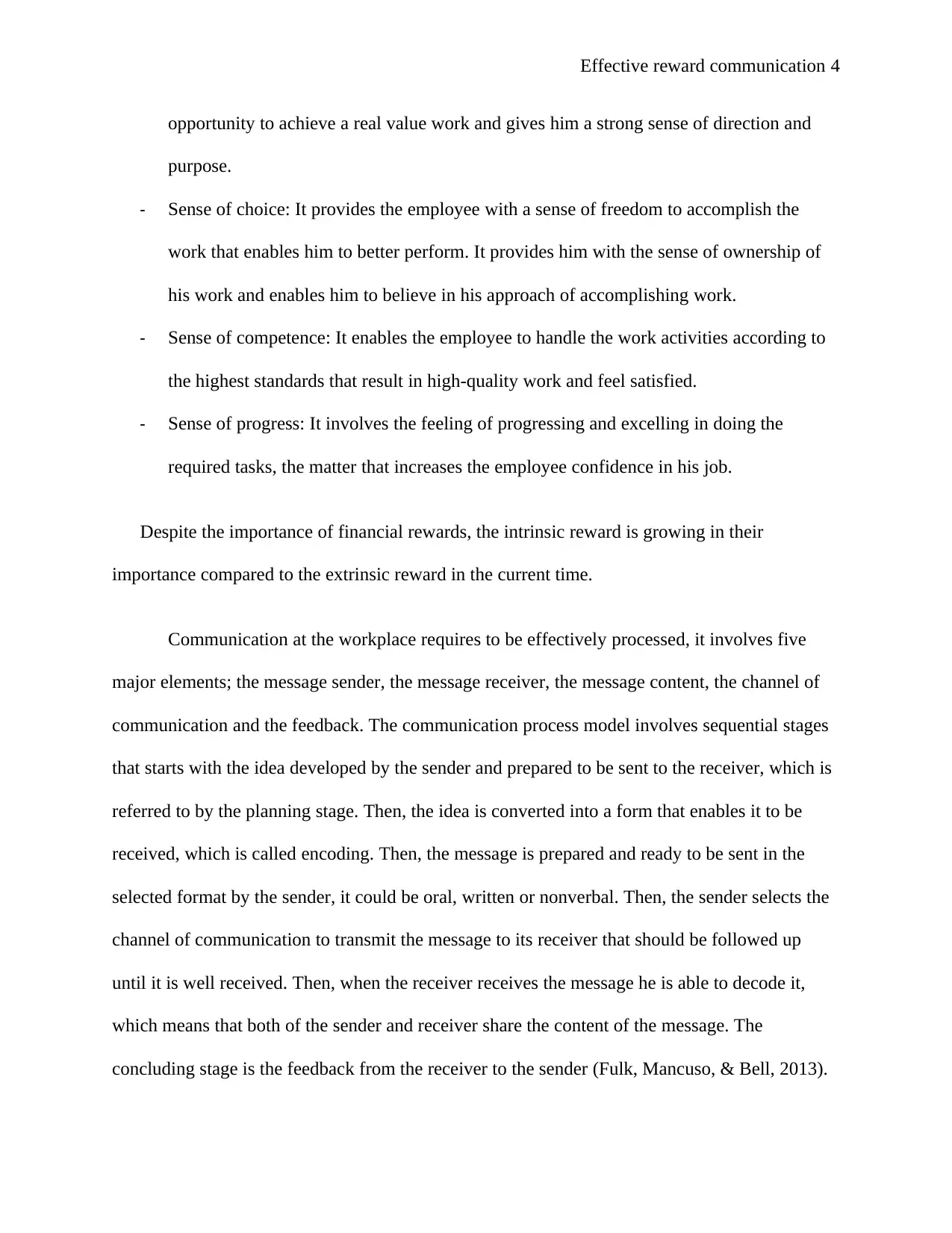
4Effective reward communication
opportunity to achieve a real value work and gives him a strong sense of direction and
purpose.
Sense of choice: It provides the employee with a sense of freedom to accomplish the
work that enables him to better perform. It provides him with the sense of ownership of
his work and enables him to believe in his approach of accomplishing work.
Sense of competence: It enables the employee to handle the work activities according to
the highest standards that result in high-quality work and feel satisfied.
Sense of progress: It involves the feeling of progressing and excelling in doing the
required tasks, the matter that increases the employee confidence in his job.
Despite the importance of financial rewards, the intrinsic reward is growing in their
importance compared to the extrinsic reward in the current time.
Communication at the workplace requires to be effectively processed, it involves five
major elements; the message sender, the message receiver, the message content, the channel of
communication and the feedback. The communication process model involves sequential stages
that starts with the idea developed by the sender and prepared to be sent to the receiver, which is
referred to by the planning stage. Then, the idea is converted into a form that enables it to be
received, which is called encoding. Then, the message is prepared and ready to be sent in the
selected format by the sender, it could be oral, written or nonverbal. Then, the sender selects the
channel of communication to transmit the message to its receiver that should be followed up
until it is well received. Then, when the receiver receives the message he is able to decode it,
which means that both of the sender and receiver share the content of the message. The
concluding stage is the feedback from the receiver to the sender (Fulk, Mancuso, & Bell, 2013).
opportunity to achieve a real value work and gives him a strong sense of direction and
purpose.
Sense of choice: It provides the employee with a sense of freedom to accomplish the
work that enables him to better perform. It provides him with the sense of ownership of
his work and enables him to believe in his approach of accomplishing work.
Sense of competence: It enables the employee to handle the work activities according to
the highest standards that result in high-quality work and feel satisfied.
Sense of progress: It involves the feeling of progressing and excelling in doing the
required tasks, the matter that increases the employee confidence in his job.
Despite the importance of financial rewards, the intrinsic reward is growing in their
importance compared to the extrinsic reward in the current time.
Communication at the workplace requires to be effectively processed, it involves five
major elements; the message sender, the message receiver, the message content, the channel of
communication and the feedback. The communication process model involves sequential stages
that starts with the idea developed by the sender and prepared to be sent to the receiver, which is
referred to by the planning stage. Then, the idea is converted into a form that enables it to be
received, which is called encoding. Then, the message is prepared and ready to be sent in the
selected format by the sender, it could be oral, written or nonverbal. Then, the sender selects the
channel of communication to transmit the message to its receiver that should be followed up
until it is well received. Then, when the receiver receives the message he is able to decode it,
which means that both of the sender and receiver share the content of the message. The
concluding stage is the feedback from the receiver to the sender (Fulk, Mancuso, & Bell, 2013).
Secure Best Marks with AI Grader
Need help grading? Try our AI Grader for instant feedback on your assignments.

5Effective reward communication
Effective communication is argued to be very important, the effective human
performance requires a well understanding of messages that share meanings. The productivity of
the employees will be enhanced through effective communication and human interaction. A
communication activity is considered to be effective when both of the sender and receiver share
similar meaning to the message. Diverse workforce, in terms of age, education levels, gender and
experience represent a major mean to ensure effective communication and negotiation at
organizations (Okoro & Washington, 2012).
The Personal Report of Communication Apprehension (PRCA) developed by McCroskey
(1982), as cited in Croucher, et al. (2016), provides a measurement of individuals
communicating ability. It measures the real and perceived communication with people through
24 questions that measure communication apprehension (CA). It considers that communication
could take place with the public, in meeting, with dyads and among small groups.
According to Chen (2012), organizational culture is strongly related to the shared
meanings across the organization boundaries that unifies people perception within the same
workplace. There exist two types of communication, including the high and low context of
communication. Diverse communication styles, including verbal, written and nonverbal
communication represent a key determinant of the organizational culture. The nonverbal
communication represents a high context of organizational culture, while the low context culture
depends more on verbal communication.
Communicating with people from different cultures within the same organization requires
readiness and preparation to effectively communicate with each other. This situation takes place
in multinational organizations, where people from different cultures have to communicate with
each other. Therefore, the willingness to communicate (WTC) influenced the managers and
Effective communication is argued to be very important, the effective human
performance requires a well understanding of messages that share meanings. The productivity of
the employees will be enhanced through effective communication and human interaction. A
communication activity is considered to be effective when both of the sender and receiver share
similar meaning to the message. Diverse workforce, in terms of age, education levels, gender and
experience represent a major mean to ensure effective communication and negotiation at
organizations (Okoro & Washington, 2012).
The Personal Report of Communication Apprehension (PRCA) developed by McCroskey
(1982), as cited in Croucher, et al. (2016), provides a measurement of individuals
communicating ability. It measures the real and perceived communication with people through
24 questions that measure communication apprehension (CA). It considers that communication
could take place with the public, in meeting, with dyads and among small groups.
According to Chen (2012), organizational culture is strongly related to the shared
meanings across the organization boundaries that unifies people perception within the same
workplace. There exist two types of communication, including the high and low context of
communication. Diverse communication styles, including verbal, written and nonverbal
communication represent a key determinant of the organizational culture. The nonverbal
communication represents a high context of organizational culture, while the low context culture
depends more on verbal communication.
Communicating with people from different cultures within the same organization requires
readiness and preparation to effectively communicate with each other. This situation takes place
in multinational organizations, where people from different cultures have to communicate with
each other. Therefore, the willingness to communicate (WTC) influenced the managers and

6Effective reward communication
researcher attention to enable people to effectively communicate with people who speak different
languages. Shahbaz et al. (2016), argued that WTC could be applied to measure individuals'
willingness level to communicate with specific individuals or groups in specific situations.
Rewarding employees is considered an investment in human capital. It requires planning
and involving the key stakeholders in planning reward communication. Effective communication
of reward establishes positive work relationships. The stakeholders include the communication
team, the rewarded staff, line managers and senior managers. The communication plan requires
defining the targeted audiences, preparing key messages, selecting styles and tones,
communication channels and other resources. The line managers are capable to communicate
motivational messages that influence the employees to work. The communication message
should be simple and clear and using the social media channels is beneficial in spreading the
rewards communication messages across. The timing of reward communication is very
important, it could be communicated among other activities that take place within the
organization. Implementing a national campaign help in reinforcing the reward message and
highly engages the employees and enable them to appreciate the benefits package that the
organization offered them. Providing an identity for the offered reward package increases the
employees' engagement, for example selecting the man of the year. Also, understanding the
employees and their best motivating method, either extrinsic or intrinsic is essential to help
managers decide how to communicate with them (Pa & Zin, 2013).
Motivating employees requires establishing trust with them and the organization and
among each other as well. These emotional linkages facilitate effective communication and
create an organization which is trustworthy (Zeffane, 2010). The extrinsic rewards have a lower
impact on employee motivation compared to the intrinsic motivation (Dias, Leite, Ramires, &
researcher attention to enable people to effectively communicate with people who speak different
languages. Shahbaz et al. (2016), argued that WTC could be applied to measure individuals'
willingness level to communicate with specific individuals or groups in specific situations.
Rewarding employees is considered an investment in human capital. It requires planning
and involving the key stakeholders in planning reward communication. Effective communication
of reward establishes positive work relationships. The stakeholders include the communication
team, the rewarded staff, line managers and senior managers. The communication plan requires
defining the targeted audiences, preparing key messages, selecting styles and tones,
communication channels and other resources. The line managers are capable to communicate
motivational messages that influence the employees to work. The communication message
should be simple and clear and using the social media channels is beneficial in spreading the
rewards communication messages across. The timing of reward communication is very
important, it could be communicated among other activities that take place within the
organization. Implementing a national campaign help in reinforcing the reward message and
highly engages the employees and enable them to appreciate the benefits package that the
organization offered them. Providing an identity for the offered reward package increases the
employees' engagement, for example selecting the man of the year. Also, understanding the
employees and their best motivating method, either extrinsic or intrinsic is essential to help
managers decide how to communicate with them (Pa & Zin, 2013).
Motivating employees requires establishing trust with them and the organization and
among each other as well. These emotional linkages facilitate effective communication and
create an organization which is trustworthy (Zeffane, 2010). The extrinsic rewards have a lower
impact on employee motivation compared to the intrinsic motivation (Dias, Leite, Ramires, &
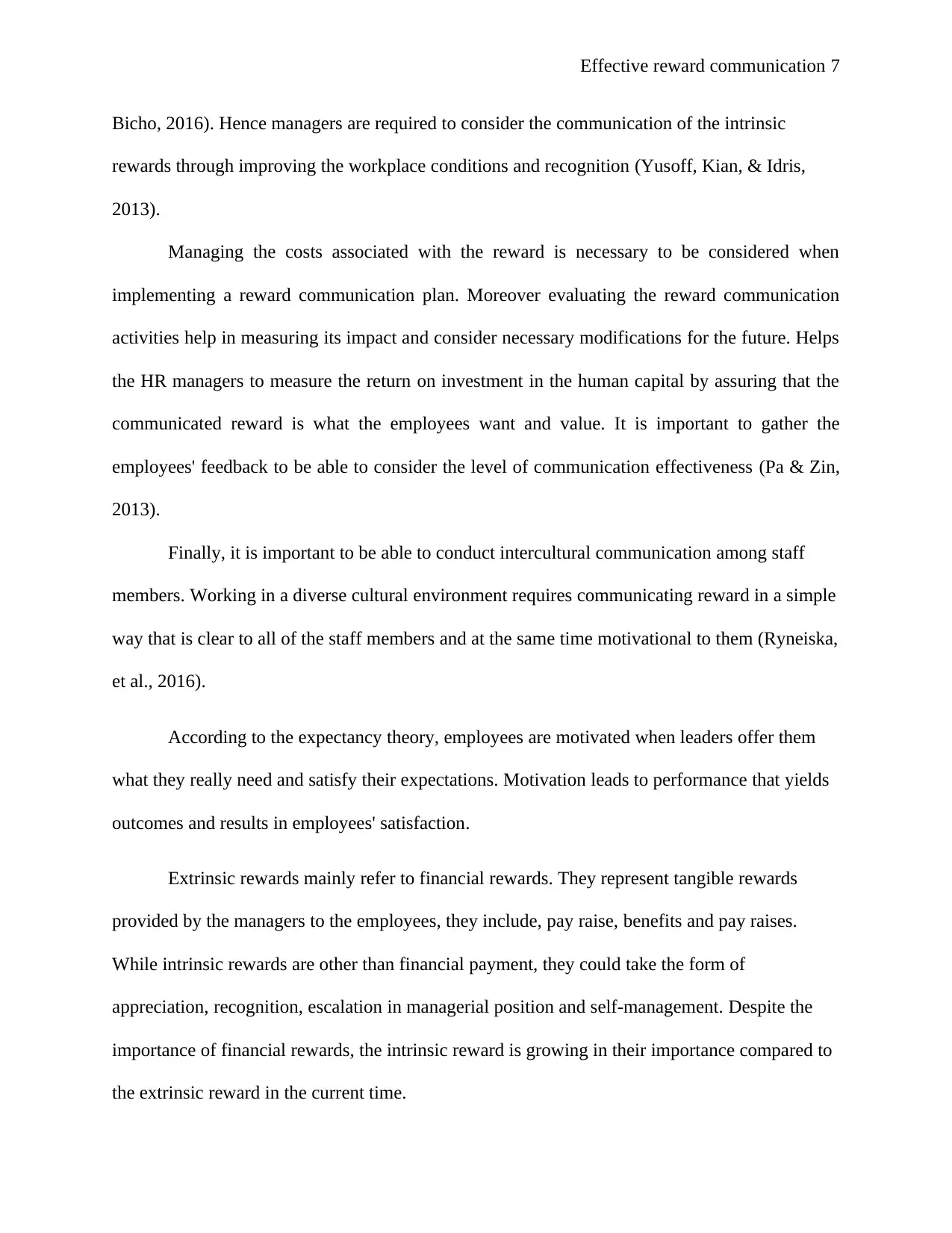
7Effective reward communication
Bicho, 2016). Hence managers are required to consider the communication of the intrinsic
rewards through improving the workplace conditions and recognition (Yusoff, Kian, & Idris,
2013).
Managing the costs associated with the reward is necessary to be considered when
implementing a reward communication plan. Moreover evaluating the reward communication
activities help in measuring its impact and consider necessary modifications for the future. Helps
the HR managers to measure the return on investment in the human capital by assuring that the
communicated reward is what the employees want and value. It is important to gather the
employees' feedback to be able to consider the level of communication effectiveness (Pa & Zin,
2013).
Finally, it is important to be able to conduct intercultural communication among staff
members. Working in a diverse cultural environment requires communicating reward in a simple
way that is clear to all of the staff members and at the same time motivational to them (Ryneiska,
et al., 2016).
According to the expectancy theory, employees are motivated when leaders offer them
what they really need and satisfy their expectations. Motivation leads to performance that yields
outcomes and results in employees' satisfaction.
Extrinsic rewards mainly refer to financial rewards. They represent tangible rewards
provided by the managers to the employees, they include, pay raise, benefits and pay raises.
While intrinsic rewards are other than financial payment, they could take the form of
appreciation, recognition, escalation in managerial position and self-management. Despite the
importance of financial rewards, the intrinsic reward is growing in their importance compared to
the extrinsic reward in the current time.
Bicho, 2016). Hence managers are required to consider the communication of the intrinsic
rewards through improving the workplace conditions and recognition (Yusoff, Kian, & Idris,
2013).
Managing the costs associated with the reward is necessary to be considered when
implementing a reward communication plan. Moreover evaluating the reward communication
activities help in measuring its impact and consider necessary modifications for the future. Helps
the HR managers to measure the return on investment in the human capital by assuring that the
communicated reward is what the employees want and value. It is important to gather the
employees' feedback to be able to consider the level of communication effectiveness (Pa & Zin,
2013).
Finally, it is important to be able to conduct intercultural communication among staff
members. Working in a diverse cultural environment requires communicating reward in a simple
way that is clear to all of the staff members and at the same time motivational to them (Ryneiska,
et al., 2016).
According to the expectancy theory, employees are motivated when leaders offer them
what they really need and satisfy their expectations. Motivation leads to performance that yields
outcomes and results in employees' satisfaction.
Extrinsic rewards mainly refer to financial rewards. They represent tangible rewards
provided by the managers to the employees, they include, pay raise, benefits and pay raises.
While intrinsic rewards are other than financial payment, they could take the form of
appreciation, recognition, escalation in managerial position and self-management. Despite the
importance of financial rewards, the intrinsic reward is growing in their importance compared to
the extrinsic reward in the current time.
Paraphrase This Document
Need a fresh take? Get an instant paraphrase of this document with our AI Paraphraser

8Effective reward communication
Effective communication is argued to be very important, the effective human
performance requires a well understanding of messages that share meanings. A communication
activity is considered to be effective when both of the sender and receiver share similar meaning
to the message.
Working in a diverse cultural environment requires communicating reward in a simple
way that is clear to all of the staff members and at the same time motivational to them. The
timing of reward communication is very important, it could be communicated among other
activities that take place within the organization.
Effective communication is argued to be very important, the effective human
performance requires a well understanding of messages that share meanings. A communication
activity is considered to be effective when both of the sender and receiver share similar meaning
to the message.
Working in a diverse cultural environment requires communicating reward in a simple
way that is clear to all of the staff members and at the same time motivational to them. The
timing of reward communication is very important, it could be communicated among other
activities that take place within the organization.
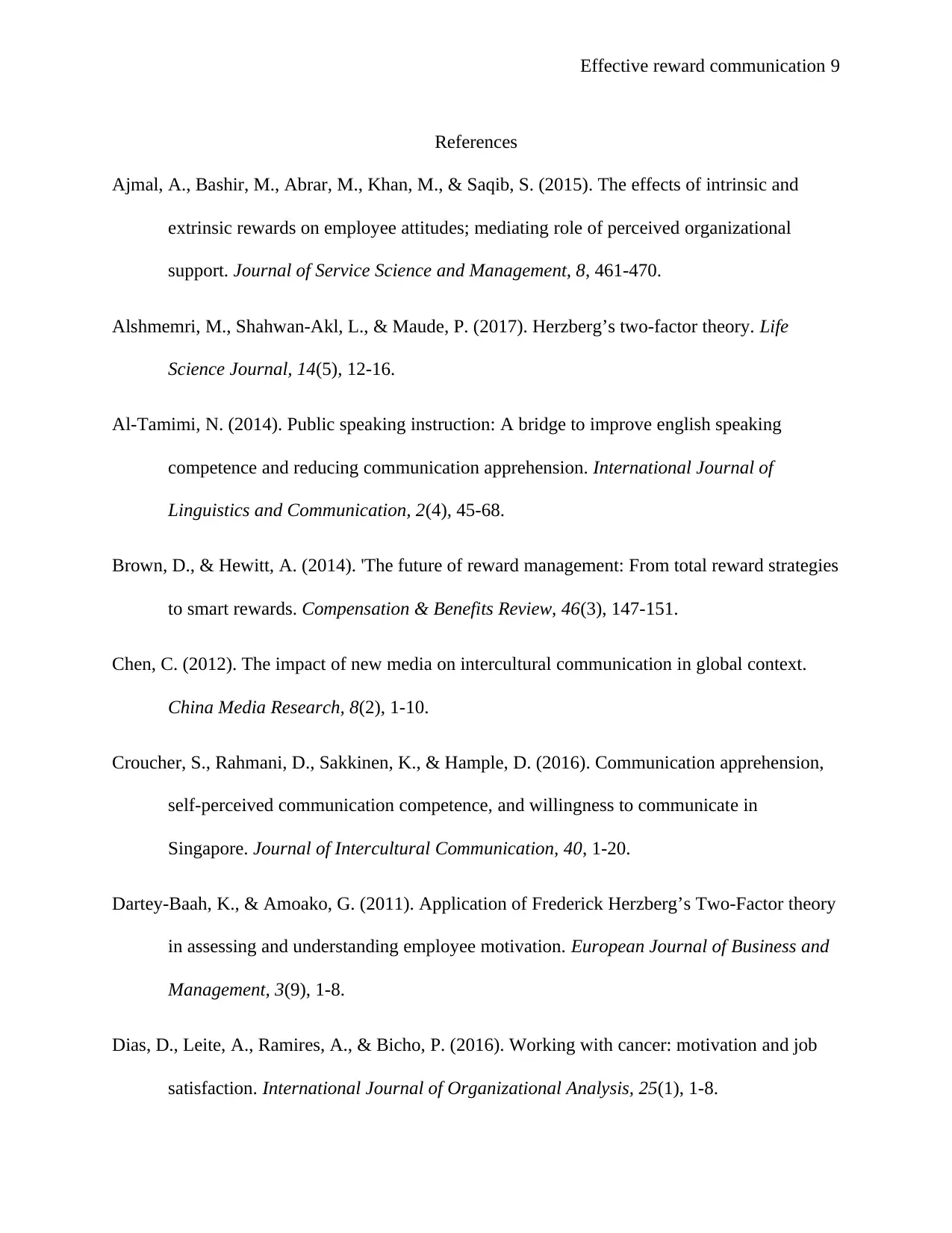
9Effective reward communication
References
Ajmal, A., Bashir, M., Abrar, M., Khan, M., & Saqib, S. (2015). The effects of intrinsic and
extrinsic rewards on employee attitudes; mediating role of perceived organizational
support. Journal of Service Science and Management, 8, 461-470.
Alshmemri, M., Shahwan-Akl, L., & Maude, P. (2017). Herzberg’s two-factor theory. Life
Science Journal, 14(5), 12-16.
Al-Tamimi, N. (2014). Public speaking instruction: A bridge to improve english speaking
competence and reducing communication apprehension. International Journal of
Linguistics and Communication, 2(4), 45-68.
Brown, D., & Hewitt, A. (2014). 'The future of reward management: From total reward strategies
to smart rewards. Compensation & Benefits Review, 46(3), 147-151.
Chen, C. (2012). The impact of new media on intercultural communication in global context.
China Media Research, 8(2), 1-10.
Croucher, S., Rahmani, D., Sakkinen, K., & Hample, D. (2016). Communication apprehension,
self-perceived communication competence, and willingness to communicate in
Singapore. Journal of Intercultural Communication, 40, 1-20.
Dartey-Baah, K., & Amoako, G. (2011). Application of Frederick Herzberg’s Two-Factor theory
in assessing and understanding employee motivation. European Journal of Business and
Management, 3(9), 1-8.
Dias, D., Leite, A., Ramires, A., & Bicho, P. (2016). Working with cancer: motivation and job
satisfaction. International Journal of Organizational Analysis, 25(1), 1-8.
References
Ajmal, A., Bashir, M., Abrar, M., Khan, M., & Saqib, S. (2015). The effects of intrinsic and
extrinsic rewards on employee attitudes; mediating role of perceived organizational
support. Journal of Service Science and Management, 8, 461-470.
Alshmemri, M., Shahwan-Akl, L., & Maude, P. (2017). Herzberg’s two-factor theory. Life
Science Journal, 14(5), 12-16.
Al-Tamimi, N. (2014). Public speaking instruction: A bridge to improve english speaking
competence and reducing communication apprehension. International Journal of
Linguistics and Communication, 2(4), 45-68.
Brown, D., & Hewitt, A. (2014). 'The future of reward management: From total reward strategies
to smart rewards. Compensation & Benefits Review, 46(3), 147-151.
Chen, C. (2012). The impact of new media on intercultural communication in global context.
China Media Research, 8(2), 1-10.
Croucher, S., Rahmani, D., Sakkinen, K., & Hample, D. (2016). Communication apprehension,
self-perceived communication competence, and willingness to communicate in
Singapore. Journal of Intercultural Communication, 40, 1-20.
Dartey-Baah, K., & Amoako, G. (2011). Application of Frederick Herzberg’s Two-Factor theory
in assessing and understanding employee motivation. European Journal of Business and
Management, 3(9), 1-8.
Dias, D., Leite, A., Ramires, A., & Bicho, P. (2016). Working with cancer: motivation and job
satisfaction. International Journal of Organizational Analysis, 25(1), 1-8.
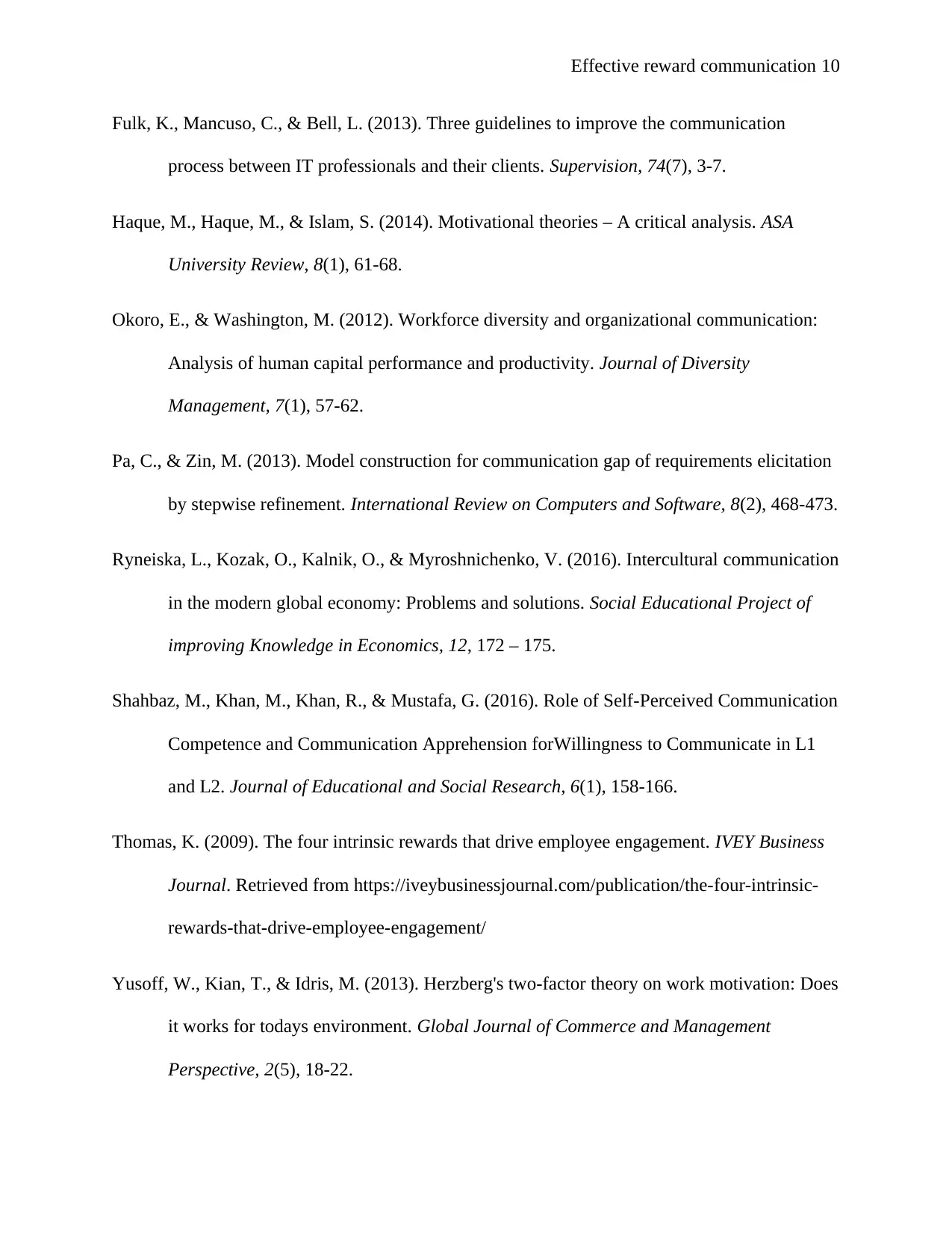
10Effective reward communication
Fulk, K., Mancuso, C., & Bell, L. (2013). Three guidelines to improve the communication
process between IT professionals and their clients. Supervision, 74(7), 3-7.
Haque, M., Haque, M., & Islam, S. (2014). Motivational theories – A critical analysis. ASA
University Review, 8(1), 61-68.
Okoro, E., & Washington, M. (2012). Workforce diversity and organizational communication:
Analysis of human capital performance and productivity. Journal of Diversity
Management, 7(1), 57-62.
Pa, C., & Zin, M. (2013). Model construction for communication gap of requirements elicitation
by stepwise refinement. International Review on Computers and Software, 8(2), 468-473.
Ryneiska, L., Kozak, O., Kalnik, O., & Myroshnichenko, V. (2016). Intercultural communication
in the modern global economy: Problems and solutions. Social Educational Project of
improving Knowledge in Economics, 12, 172 – 175.
Shahbaz, M., Khan, M., Khan, R., & Mustafa, G. (2016). Role of Self-Perceived Communication
Competence and Communication Apprehension forWillingness to Communicate in L1
and L2. Journal of Educational and Social Research, 6(1), 158-166.
Thomas, K. (2009). The four intrinsic rewards that drive employee engagement. IVEY Business
Journal. Retrieved from https://iveybusinessjournal.com/publication/the-four-intrinsic-
rewards-that-drive-employee-engagement/
Yusoff, W., Kian, T., & Idris, M. (2013). Herzberg's two-factor theory on work motivation: Does
it works for todays environment. Global Journal of Commerce and Management
Perspective, 2(5), 18-22.
Fulk, K., Mancuso, C., & Bell, L. (2013). Three guidelines to improve the communication
process between IT professionals and their clients. Supervision, 74(7), 3-7.
Haque, M., Haque, M., & Islam, S. (2014). Motivational theories – A critical analysis. ASA
University Review, 8(1), 61-68.
Okoro, E., & Washington, M. (2012). Workforce diversity and organizational communication:
Analysis of human capital performance and productivity. Journal of Diversity
Management, 7(1), 57-62.
Pa, C., & Zin, M. (2013). Model construction for communication gap of requirements elicitation
by stepwise refinement. International Review on Computers and Software, 8(2), 468-473.
Ryneiska, L., Kozak, O., Kalnik, O., & Myroshnichenko, V. (2016). Intercultural communication
in the modern global economy: Problems and solutions. Social Educational Project of
improving Knowledge in Economics, 12, 172 – 175.
Shahbaz, M., Khan, M., Khan, R., & Mustafa, G. (2016). Role of Self-Perceived Communication
Competence and Communication Apprehension forWillingness to Communicate in L1
and L2. Journal of Educational and Social Research, 6(1), 158-166.
Thomas, K. (2009). The four intrinsic rewards that drive employee engagement. IVEY Business
Journal. Retrieved from https://iveybusinessjournal.com/publication/the-four-intrinsic-
rewards-that-drive-employee-engagement/
Yusoff, W., Kian, T., & Idris, M. (2013). Herzberg's two-factor theory on work motivation: Does
it works for todays environment. Global Journal of Commerce and Management
Perspective, 2(5), 18-22.
Secure Best Marks with AI Grader
Need help grading? Try our AI Grader for instant feedback on your assignments.

11Effective reward communication
Zeffane, R. (2010). Towards a two-factor theory of interpersonal trust: a focus on trust in
leadership . International Journal of Commerce and Management, 20(3), 246-257.
Zeffane, R. (2010). Towards a two-factor theory of interpersonal trust: a focus on trust in
leadership . International Journal of Commerce and Management, 20(3), 246-257.
1 out of 11
Related Documents
Your All-in-One AI-Powered Toolkit for Academic Success.
+13062052269
info@desklib.com
Available 24*7 on WhatsApp / Email
![[object Object]](/_next/static/media/star-bottom.7253800d.svg)
Unlock your academic potential
© 2024 | Zucol Services PVT LTD | All rights reserved.





